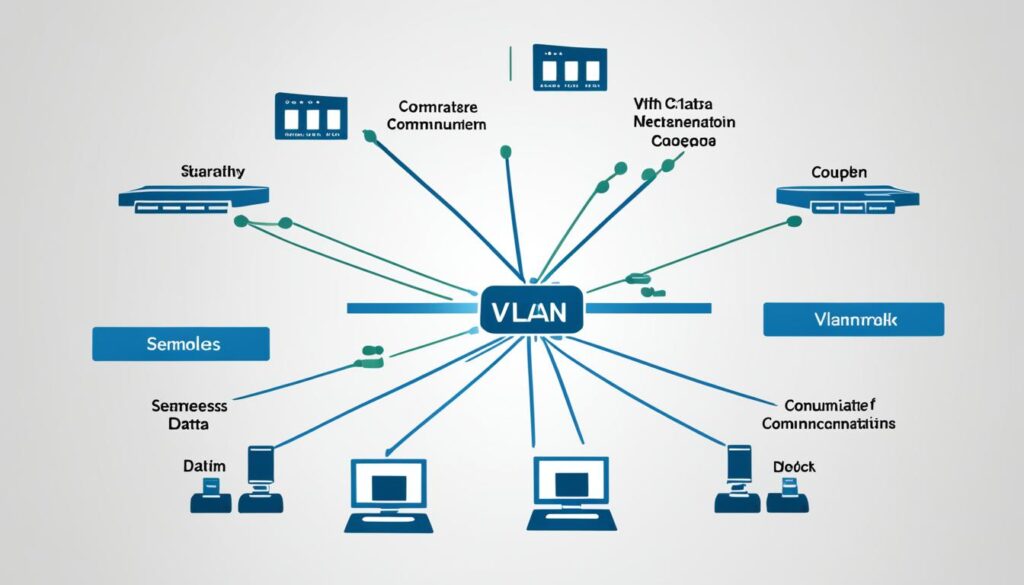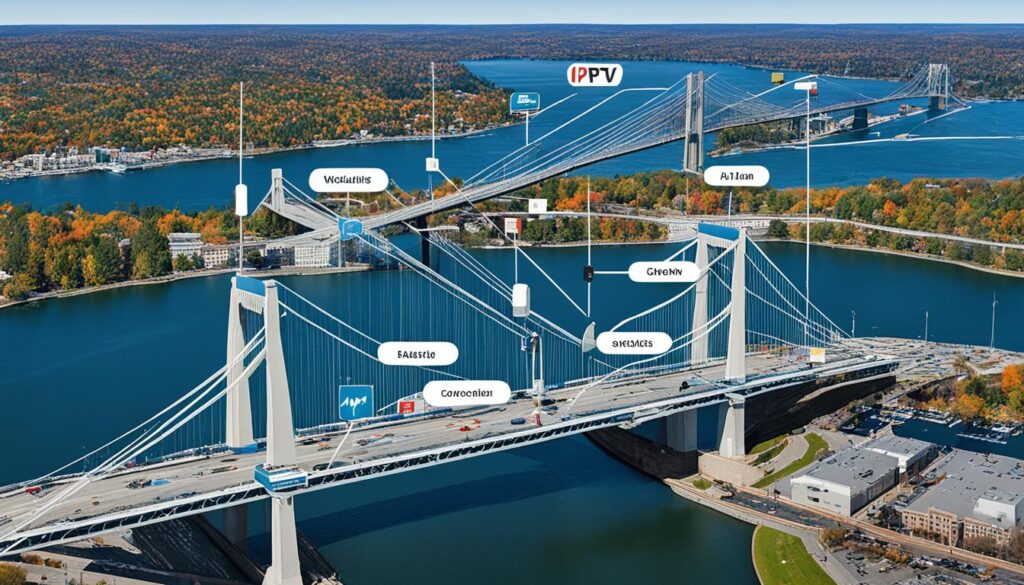When it comes to optimizing your home networking setup and enhancing your streaming experience, understanding the difference between IPTV (Internet Protocol Television) and VLAN (Virtual Local Area Network) can make a significant difference.
Both technologies play distinct roles in network performance, security, and manageability. Let’s delve into the comparison and explore how integrating IPTV with VLAN can revolutionize your streaming setups.
Key Takeaways:
- IPTV delivers television content over IP networks, offering greater flexibility and interactivity compared to traditional options.
- VLAN allows devices on a single physical network to be segmented into multiple isolated virtual networks.
- Integrating IPTV with VLAN enhances streaming performance and network security.
- VLAN improves manageability and traffic management by separating different types of network traffic.
- IPTV and VLAN have different network architectures, with IPTV focusing on content delivery and VLAN on network segmentation.
What Is IPTV?
IPTV (Internet Protocol Television) is a service that delivers television programming and other video content using the TCP/IP suite, unlike broadcast TV, cable TV, or satellite signals.
It is typically distributed by a service provider and allows users to access live TV programs and on-demand video content via IP networks.
IPTV can be used in enterprise settings to provide video content over a private network, although subscriber-based models are more common due to complexity, network latency, and scaling issues.
IPTV content is often delivered over a managed or dedicated network, giving network operators more control over video traffic and the ability to ensure quality of service, uptime, bandwidth, and reliability.
In traditional television delivery, all programming is broadcast simultaneously in a multicast format, while IPTV sends only one program at a time in a unicast format.
Content remains on the service provider’s network, and only the selected program is sent to the user’s device when they change the channel.
IPTV requires a set-top box or other customer premises devices like Wi-Fi routers or broadband internet connections.
IPTV uses IP multicasting with Internet Group Management Protocol for IPv4-based live television broadcasts and Real-Time Streaming Protocol for on-demand programs, with Multicast Listener Discovery used on IPv6 networks.
It offers various services and applications such as video on demand, interactive TV, live streaming, in-program messaging, and time shifting, enabling viewers to consume content in ways other than live broadcasts.
IPTV can be bundled with other IP-based telecommunication services like voice over IP and high-speed internet.
Major IPTV providers include network operators like Verizon, major companies like Netflix, Google, Apple, and Microsoft, as well as Sony, AT&T, Roku, Hulu, YouTube, and many others. There are also smaller or niche companies specializing in certain types of content delivered over a broadband IP connection.
What Is VLAN?
VLAN (Virtual Local Area Network) is a networking technology that improves network performance, security, and manageability by segmenting devices on a single physical network into multiple, isolated virtual networks. This segmentation allows for efficient traffic management, preventing congestion and enhancing overall network performance.
Each VLAN is assigned a unique identifier called the VLAN ID, which distinguishes it from other virtual networks. By separating different types of traffic, such as voice, data, and video, into distinct VLANs, network resources can be optimized, and network security can be enhanced.
VLANs isolate different types of traffic, preventing unauthorized access between VLANs and reducing the attack surface of a network. This helps to prioritize and isolate specific types of traffic, enhancing overall network performance and improving the streaming experience.
Network administrators can easily configure and control each virtual network separately, providing greater manageability. VLANs commonly find applications in enterprise networks to organize and separate different departments or user groups, ensuring better performance and security.
To configure VLANs, network switches are used to designate specific ports for each virtual network. Devices connected to these ports become part of the corresponding VLAN. The flexibility of VLANs allows them to be used in combination with other networking technologies, such as IPTV, to further optimize network performance and enhance streaming experiences.

VLAN Benefits and Usage
VLANs offer several benefits and are commonly used in various network environments:
- Better performance: By segmenting network traffic, VLANs enable efficient traffic management, preventing congestion and optimizing network resources.
- Enhanced security: VLANs isolate different types of traffic, preventing unauthorized access between virtual networks and reducing the attack surface of a network.
- Improved manageability: Network administrators can easily configure and control each virtual network separately, providing greater flexibility and manageability.
- Departmental or user group separation: VLANs are commonly used in enterprise networks to organize and separate different departments or user groups, ensuring better performance and security.
Overall, VLANs are a powerful networking technology that enhances performance, security, and manageability in various network environments.
Benefits of IPTV and VLAN Integration
Integrating IPTV with VLAN brings several benefits to home networking setups. By combining these technologies, users can optimize their network performance, enhance streaming performance, improve security, and efficiently manage network traffic.
1. Optimized Network Performance
Integrating IPTV with VLAN allows for the prioritization and isolation of IPTV traffic. This optimization ensures smoother streaming experiences by reducing buffering and minimizing lag during streaming sessions. With the integration, users can enjoy uninterrupted viewing of their favorite content without any disruptions.
2. Enhanced Network Security
One of the advantages of IPTV VLAN integration is the increased network security it provides. VLANs isolate IPTV traffic, preventing unauthorized access to IPTV services. Only authenticated devices with proper VLAN configuration can access the content, ensuring a secure and protected streaming environment.
3. Improved Traffic Management
The combination of IPTV and VLAN enables the separation and prioritization of different types of network traffic, such as voice, data, and video. VLANs ensure the efficient utilization of network resources by preventing congestion and reducing packet loss. This improved traffic management enhances overall network performance and ensures a seamless streaming experience.
4. Better Network Control and Manageability
VLANs provide network administrators with better control and manageability of the network. By configuring and monitoring each virtual network separately, administrators can allocate bandwidth and prioritize traffic effectively. This allows for the best streaming experience for users on the network, ensuring optimal performance for IPTV services.
5. Simplified Network Setup and Management
IPTV VLAN integration simplifies network setup and management by consolidating different types of traffic onto a single network infrastructure. This consolidation reduces complexity and improves scalability, making it easier to configure and maintain the network. With a streamlined setup, users can enjoy a seamless and hassle-free IPTV streaming experience.
| Benefits | Description |
|---|---|
| Optimized Network Performance | Prioritizing and isolating IPTV traffic for smooth streaming experiences |
| Enhanced Network Security | Preventing unauthorized access to IPTV services |
| Improved Traffic Management | Efficient utilization of network resources and reduced congestion |
| Better Network Control and Manageability | Configuring and prioritizing traffic for the best streaming experience |
| Simplified Network Setup and Management | Consolidating traffic for easier configuration and maintenance |
Network Architecture Differences Between IPTV and VLAN
IPTV (Internet Protocol Television) and VLAN (Virtual Local Area Network) have distinct network architectures that cater to their unique purposes and functionalities.
IPTV Network Architecture:
- IPTV focuses on delivering television content over IP networks.
- Unicast transmission is used for streaming on-demand content.
- Multicast transmission is employed for live TV broadcasts.
- The content remains on the service provider’s network.
- Only the selected program is sent to the user’s device when they change the channel.
- Set-top boxes or customer premises devices are required to receive and decode the transmitted content.
VLAN Network Architecture:
- VLAN is designed to segment a single physical network into multiple isolated virtual networks.
- VLANs use VLAN tags to identify and separate different virtual networks.
- Each VLAN operates independently, enhancing network performance and security.
- Network switches play a crucial role in facilitating traffic routing and segmentation.
- VLAN network architecture enables effective network traffic management and resource allocation.
- Network segmentation provided by VLANs enhances security by isolating different types of traffic.

The combination of IPTV and VLAN technologies allows for effective network traffic separation and optimization, ensuring smooth streaming experiences and enhanced security.
Comparison of IPTV and VLAN Network Architectures:
| IPTV Network Architecture | VLAN Network Architecture |
|---|---|
| Focuses on delivering television content over IP networks | Designed to segment a single physical network into multiple isolated virtual networks |
| Utilizes unicast transmission for on-demand content | Uses VLAN tags to identify and separate different virtual networks |
| Utilizes multicast transmission for live TV broadcasts | Operates independently, enhancing network performance and security |
| Content remains on the service provider’s network | Facilitates traffic routing and segmentation through network switches |
| Requires set-top boxes or customer premises devices | Enables effective network traffic management and resource allocation |
| Enhances security by isolating different types of traffic |
The network architecture differences between IPTV and VLAN stem from their distinct functionalities and objectives. While IPTV focuses on delivering television content over IP networks, VLAN allows for network segmentation, traffic separation, and enhanced performance and security.
Conclusion
IPTV and VLAN are two distinct technologies that offer significant benefits in home networking setups. IPTV focuses on delivering television content over IP networks, providing greater flexibility, personalization, and interactivity compared to traditional options. VLAN, on the other hand, separates and isolates devices within a single physical network, improving network performance, security, and manageability.
By integrating IPTV with VLAN, you can enhance streaming performance by prioritizing and isolating IPTV traffic. This ensures smooth and reliable streaming experiences, with reduced buffering or lag during streaming sessions. Moreover, the integration enhances network security by preventing unauthorized access to IPTV services, ensuring that only authenticated devices can access the content.
In addition to performance and security, the combination of IPTV and VLAN simplifies network setup and management, providing a seamless, high-quality viewing experience for all users on the network. It optimizes traffic management by efficiently allocating network resources, preventing congestion, reducing packet loss, and ensuring efficient utilization of your home network.
To optimize your home networking for IPTV streaming, consider the benefits of integrating IPTV with VLAN technology. This integration can open up possibilities for network optimization, enhanced streaming performance, and improved security, ultimately providing you with a superior entertainment experience and peace of mind.
Check out other helpful resources:
Is IPTV Legal? What You Should Know About IPTV Laws In 2023
What Does HW (Hardware Decorder) Mean In IPTV Players
What Is A IPTV Asus Router – Digitalizard
FAQ
What is the difference between IPTV and VLAN?
IPTV is a digital television broadcasting system that delivers television content over IP networks, offering flexibility and interactivity. VLAN, on the other hand, is a networking technology that allows devices on a single physical network to be segmented into multiple isolated virtual ones.
What is IPTV?
IPTV, or Internet Protocol Television, is a service that delivers television programming and video content using the TCP/IP suite. It allows users to access live TV programs and on-demand video content via IP networks, offering greater flexibility and personalization compared to traditional broadcast, cable, or satellite TV.
What is VLAN?
VLAN, or Virtual Local Area Network, is a networking technology that segments devices within a single physical network into multiple isolated virtual networks. It improves network performance, security, and manageability by separating different types of traffic and allowing for more efficient resource allocation and traffic prioritization.
What are the benefits of integrating IPTV and VLAN?
Integrating IPTV with VLAN enhances streaming performance by prioritizing and isolating IPTV traffic, ensuring smooth and reliable streaming experiences. It also improves network security by preventing unauthorized access to IPTV services and enhances traffic management by allocating network resources efficiently.
How does the network architecture differ between IPTV and VLAN?
The network architecture for IPTV focuses on delivering television content over IP networks, utilizing unicast and multicast transmission. On the other hand, VLAN network architecture is designed to segment a single physical network into isolated virtual ones, enhancing performance and security by separating different types of traffic.
What can IPTV and VLAN bring to home networking setups?
By integrating IPTV with VLAN, home networking setups can experience optimized network performance, enhanced streaming quality, and improved security. It allows for efficient traffic prioritization, prevents congestion, and ensures that only authenticated devices can access IPTV services on the network.





